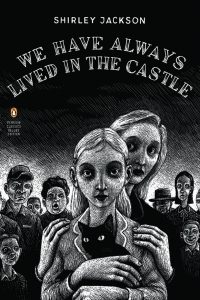#myfavoritebook: We Have Always Lived in the Castle by Shirley Jackson
Micaela Pryor//Blog Writer
Shirley Jackson’s final novel We Have Always Lived in the Castle is an underrated classic, a gothic tale of murder, money, and persecution. Her clear, biting style is unforgettable, turning a mansion otherworldly and a family totally alien. The book centers on Constance Blackwood, an agoraphobic and mild-mannered homemaker, and her younger sister Mary Katherine, or “Merricat,” a devilish rogue who wields her superstitions like magic. The two sisters are theorized to be the two halves of Jackson’s own psyche, nervous and mischievous in equal parts. The sisters live with their addled and fragile Uncle Julian, a man who spends his days writing in excruciating detail about the day the rest of the once-large Blackwood family died of arsenic poisoning. Together, the odd trio occupy the Blackwood estate, a large, gated home with sprawling gardens and a vault of wealth in the basement. Constance, Merricat, and Uncle Julian live their lives in perfect order, their days happily planned down to the hour. But a wrench is thrown into the routine the night a shady Cousin Charles arrives, suspiciously polite and eager to assist with the Blackwood finances.

The Blackwood sisters face antagonism both surreptitious and overt, the former from Charles and the latter from the entirety of the village they live in. The villagers openly despise the Blackwoods, a feeling perpetuated partially by the evidence linking Constance to the mysterious family deaths. Children in the village shout rhymes at Merricat as she goes about her shopping: “Merricat, said Connie, would you like a cup of tea? Oh no, said Merricat, you’ll poison me.” The other source of their contempt lies in the remaining Blackwoods’ exuberant wealth and snobbery, features neither sister bothers to downplay. The hatred simmering among the villagers permeates the novel, creating a tension that, when brought to a boil, leaves the reader in fear for the Blackwood sisters’ lives.
Any fan of an unreliable narrator will appreciate Merricat’s voice, naive and wicked at once, with a curious nature bordering on unhinged. In one page she will bury a box of silver dollars as a charm of protection, and in another she will wish death upon everyone in the village. She is antisocial with a deep hate for anything new, especially the scheming Charles and his forced entry into her home. The reverential way she describes Constance, blonde and beautiful as a fairy princess, is at times charming, and at others indicative of a strange and obsessive mind. Merricat is stated to be eighteen, but by how other characters infantilize her, it’s easy to see her as much younger, nearly a child. Though warped, her perspective is distinct, viewing the events of the story with equal parts creativity and cruelty.
Reading this novel feels like watching a house fire in slow motion, beautiful and horrifying, impossible to look away. Merricat’s strange rituals, Charles’ manipulation of Constance’s emotions, and the ire of the villagers culminate in a violent shattering of the Blackwoods’ isolated world. Jackson’s gothic prose paints vivid images of nature and architecture in tandem with themes of class, alienation, and the evils that exist in everyday people. We Have Always Lived in the Castle haunts and inspires, the hallmark of Shirley Jackson’s writing throughout her career.
